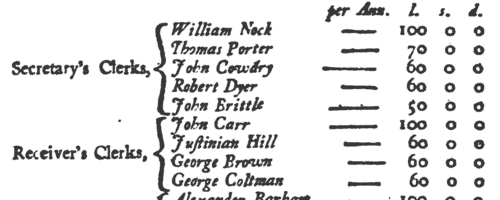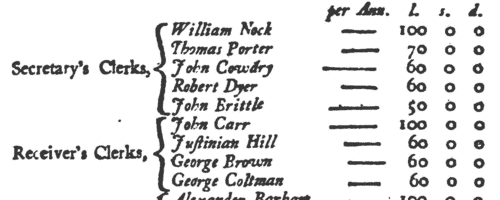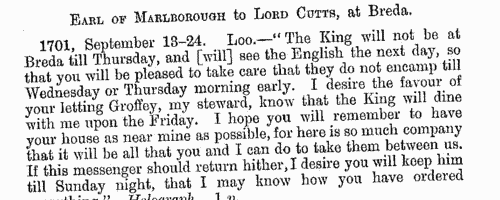Ranby Surname Ancestry ResultsOur indexes 1000-1999 include entries for the spelling 'ranby'. In the period you have requested, we have the following 39 records (displaying 1 to 10): Single Surname Subscription | | | Buying all 39 results of this search individually would cost £216.00. But you can have free access to all 39 records for a year, to view, to save and print, for £100. Save £116.00. More... |
These sample scans are from the original record. You will get scans of the full pages or articles where the surname you searched for has been found. Your web browser may prevent the sample windows from opening; in this case please change your browser settings to allow pop-up windows from this site. Close Rolls (1234-1237)
The close rolls of the 19th to 21st years of the reign of king Henry III, that is from 28 October 1234 to 27 October 1237, record the main artery of government administration in England, the orders sent out day by day to individual officers, especially sheriffs of shires: they are an exceptionally rich source for so early a period. Most of the contents relate to England, but there are also entries concerning Wales, Scotland, Ireland and the English possessions in France. This calendar was prepared by staff of the Public Record Office and published in 1908. Latin.
RANBY. Cost: £6.00.  | Sample scan, click to enlarge

| Tenants, founders and incumbents of Yorkshire chantries
(1546-1548)
Chantries were established to perform services for the souls of their founders and other faithful dead, including annual obits and anniversaries at which alms were usually distributed. The chantries could be at an existing altar in a parish church, a new altar in a side chapel of an existing church, in a new chapel in the churchyard or some miles from an existing church: few were founded before 1300, and most date from 1450 to 1500. Hospitals were places provided by similar foundations to receive the poor and weak; there were also religious guilds, brotherhoods and fraternities, and colleges (like large chantries at which three or more secular priests lived in common). An Act of Parliament of 1545 gave king Henry VIII the power to dissolve such chantries, chapels, &c., the proceeds to be devoted to the expenses of the wars in France and Scotland. Commissioners were appointed 14 February 1546 to survey the chantries and seize their property, and from 1546 to 1548 the commissioners produced these certificates giving brief details of the establishment and nature of each foundation, with an inventory of valuables and rental of lands. The individuals named in the certificates are thus the founder, the present incumbent, and the tenants whose rents provided the chantry's income. All the surviving certificates were edited by William Page for the Surtees Society, and published from 1892.RANBY. Cost: £6.00.  | Sample scan, click to enlarge

|  Masters and Apprentices
(1715) Masters and Apprentices
(1715)
Apprenticeship indentures and clerks' articles were subject to a 6d or 12d per pound stamp duty: the registers of the payments usually give the master's trade, address, and occupation, and the apprentice's father's name and address, as well as details of the date and length of the apprenticeship. 1 January to 30 April 1715.RANBY. Cost: £8.00.  | Sample scan, click to enlarge

|  Masters and Apprentices
(1726) Masters and Apprentices
(1726)
Apprenticeship indentures and clerks' articles were subject to a 6d or 12d per pound stamp duty: the registers of the payments usually give the master's trade, address, and occupation, and the apprentice's father's name and address, as well as details of the date and length of the apprenticeship. 3 January to 31 December 1726RANBY. Cost: £8.00.  | Sample scan, click to enlarge

|  Masters and Apprentices
(1730) Masters and Apprentices
(1730)
Apprenticeship indentures and clerks' articles were subject to a 6d or 12d per pound stamp duty: the registers of the payments usually give the master's trade, address, and occupation, and the apprentice's father's name and address, as well as details of the date and length of the apprenticeship. 16 March to 31 December 1730.RANBY. Cost: £8.00.  | Sample scan, click to enlarge

| Members of the Royal Society
(1741)
'A General List, or Catalogue, Of all the Offices and Officers Employ'd In the several Branches of his Majesty's Government Ecclesiastical, Civil, Military, &c. In South-Britain, or England' gives the names (and often the annual salaries) of the government functionaries, civil servants, churchmen and military, systematically arranged section by section. Section 66 lists the council and members of the Royal Society, including 'Persons of other Nations'.RANBY. Cost: £6.00.  | Sample scan, click to enlarge

| The Royal Household
(1741)
'A General List, or Catalogue, Of all the Offices and Officers Employ'd In the several Branches of his Majesty's Government Ecclesiastical, Civil, Military, &c. In South-Britain, or England' gives the names (and often the annual salaries) of the government functionaries, civil servants, churchmen and military, systematically arranged section by section. Section 79 lists the King's Officers and Servants in Ordinary Above Stairs, under the Lord Chamberlain, including the Grooms of the Bedchamber, the Gentlemen of the Privy Chamber, Cup Bearers, Carvers, Gentlemen-Sewers, Gentlemen-Ushers of the Privy Chamber, Daily Waiters, Grooms of the Privy Chamber, Quarterly Waiters in Ordinary, Sewers of the Chamber, Pages of the Presence Chamber, Grooms of the Great Chamber, Coffer Bearers, Pages of the Bedchamber and Back Stairs, Officers in the Removing Wardrobe, Standing Wardrobe keepers, the Master of the Robes and his officials, the Waiters of the Robes, Laundress of the Body Linen, Sempstress, Starcher, Necessary Women, Treasurer and Comptroller of the Chamber, Master of the Jewel Office, Master of the Ceremonies, Serjeants-at-Arms, and a host of messengers, musicians, physicians, apothecaries and surgeons; together with the housekeepers for the various palaces, and other royal servants and officials throughout the realm.RANBY. Cost: £6.00.  | Sample scan, click to enlarge

| Nottinghamshire Marriage Licences
(1701-1753)
Nottingham Archdeaconry, which was almost coextensive with the county of Nottingham, lay in the diocese and province of York, but it had substantially independent jurisdiction for both probate and the issuing of marriage licences. These are abstracts of the archdeaconry marriage licences: they usually state the groom's address, occupation, age, and condition; the bride's address, age and condition; and the names of the churches or parishes at which it was intended the marriage would be celebrated. Not all licences led to marriages. Where the age given is 21, it should be construed as '21 or over'. There was no obligation for the marriage to take place at the parish suggested, but the licence would only be valid within the county. These abstracts have been annotated with extra information found on the marriage bonds. 26 Nottinghamshire parishes (Beckingham, Darlton, Dunham, Eaton, North Leverton, Ragnall, Rampton, South Wheatley, Cropwell Bishop, Bleasby, Blidworth, Calverton, Caunton, Edingley, Farnsfield, Halloughton, Holme, Kirklington, Morton, North Muskham, Norwell, Oxton, South Muskham, Southwell, Upton and Woodborough) lay within the small peculiar jurisdiction of Southwell, which issued its own licences: abstracts of these for the period 1755 to 1833 are also included here.RANBY. Cost: £4.00.  | Sample scan, click to enlarge

| Russell family correspondence
(1670-1754)
Mrs S. C. Lomas of the Historical Manuscripts Commission prepared this report on the manuscripts of Mrs Frankland-Russell-Astley of Chequers Court in Buckinghamshire, published in 1900. There are a few items included earlier than 1670, and a few later than 1754, but broadly the collection was divided into three groups: 1. Russell and Frankland correspondence 1657 to 1697; 2. Cutts and Revett papers 1687 to 1708; 3. Colonel Charles Russell's letters 1742 to 1754. Sir John Russell was married to Frances, daughter of Oliver Cromwell; their daughter Elizabeth married sir Thomas Frankland. Their son John Russell, governor of Fort William in Bengal, married as his second wife Joanna (niece of Lord Cutts) widow of colonel Edmund Revett; and John's son, colonel Charles Russell married Colonel Revett's daughter, Mary Joanna. The largest part of this collection is the correspondence of Colonel Russell, of the 1st Regiment of Foot, and later of the Coldstream Guards, soldiering in the Netherlands.RANBY. Cost: £4.00.  | Sample scan, click to enlarge

|  Masters of Apprentices
(1757) Masters of Apprentices
(1757)
Apprenticeship indentures and clerks' articles were subject to a 6d or 12d per pound stamp duty: the registers of the payments usually give the master's trade, address, and occupation, and the apprentice's name, as well as details of the date and length of the apprenticeship. 1 January to 31 December 1757.RANBY. Cost: £8.00.  | Sample scan, click to enlarge

|
Research your ancestry, family history, genealogy and one-name study by direct access to original records and archives indexed by surname.
|













